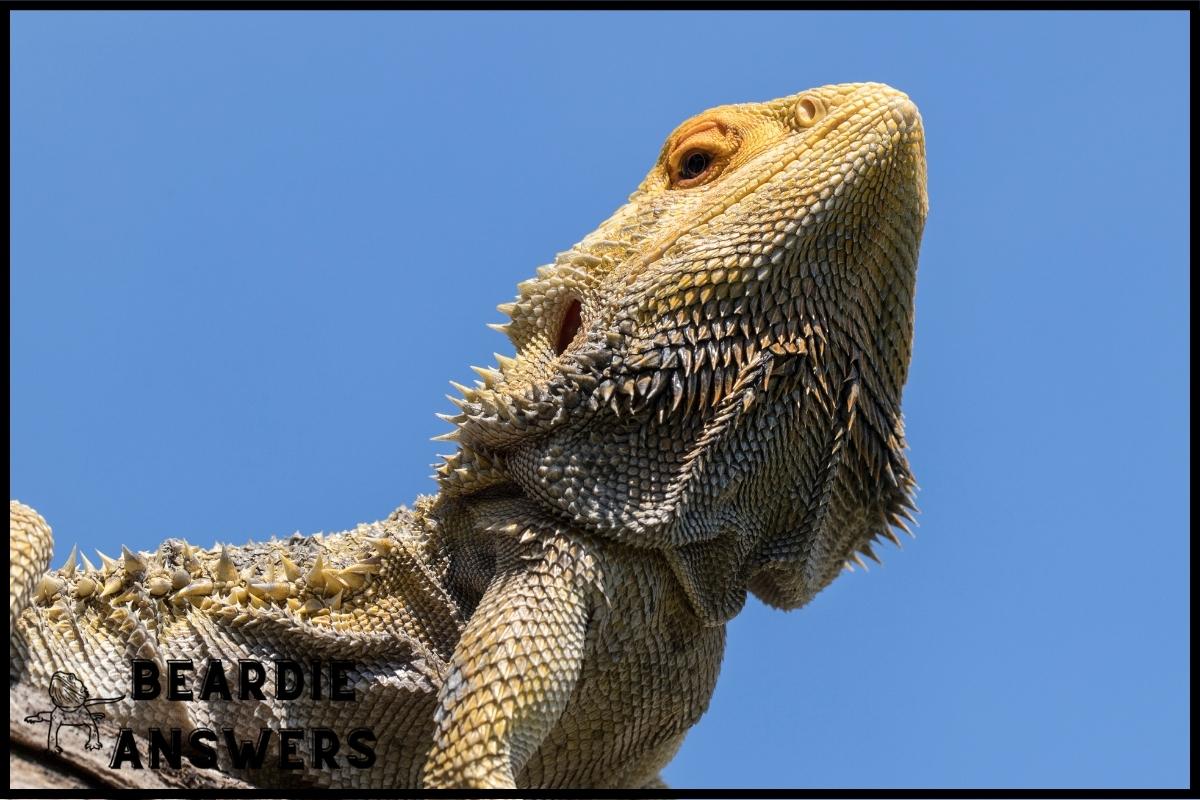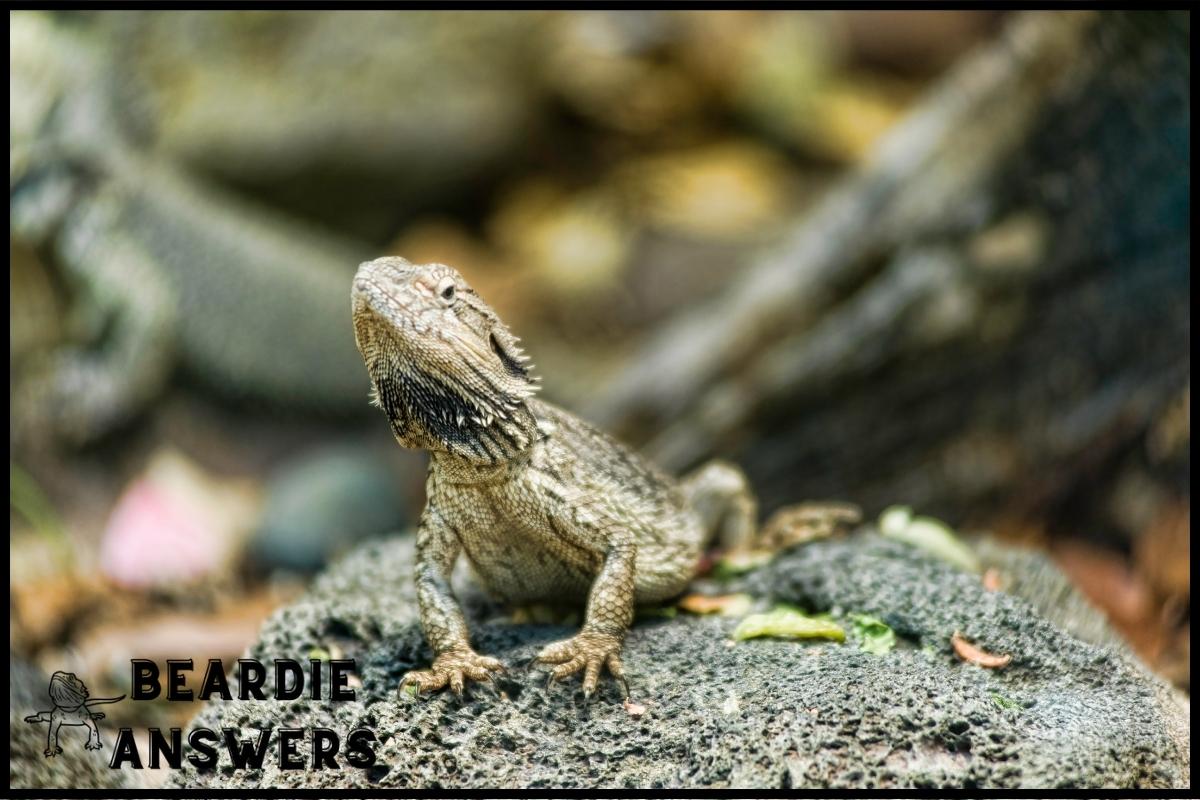Bearded dragons require a spacious enclosure that allows them to move around freely and perform their natural behaviors. Juvenile bearded dragons should be housed in a tank that is at least 40 gallons, while adults need a minimum of 75 gallons to thrive.
What You'll Learn
The Basics Of Enclosure Requirements
When it comes to understanding the basics of enclosure requirements for bearded dragons, there are a few things to consider.
Tank materials and habitat setup are both important aspects when caring for these reptiles. Selecting the right type of tank is essential in providing your dragon with the best environment possible.
Aquariums or terrariums designed specifically for reptiles make great enclosures as they provide enough space for your beardie to move around freely. The glass walls also allow you to easily monitor temperature, humidity levels, and other environmental parameters necessary for proper care. Additionally, look into purchasing tanks that come with secure lids on top to prevent escape attempts from curious hatchlings and adults alike!
Providing an adequate amount of substrate material is just as important as selecting the right kind of tank. Substrates such as sand, mulch, or reptile carpet can all be used effectively in creating the perfect home for your pet dragon while also allowing easy cleaning and maintenance.
It’s also beneficial to include plenty of branches and hides where they can retreat if needed; this allows them to feel safe and secure within their habitat which helps promote healthy growth and development.
Transitioning now into discussing choosing the right size tank…
Choosing The Right Size Tank
It has been widely accepted that the size of a tank for bearded dragons should be at least 40 gallons for juveniles and 75 gallons for adults.
However, there are additional considerations to keep in mind when choosing just the right tank size:
- Warming lamps – these will take up space depending on the type you choose; some may rest above the enclosure while others require a dedicated area outside it.
- Substrate types – different substrate materials have varying depths; this could affect overall capacity of your tank if not accounted for properly.
- Tank decorations – plants and other accessories must fit within the confines of your chosen enclosure; having too much can lead to an overcrowded situation which is never ideal.
As such, it’s important to do your research before making any decisions as even small details can greatly impact how comfortable and healthy your pet is going to be in its new home.
With all these factors taken into consideration, we can now begin looking at how best to utilize tank accessories to create an inviting environment for our scaly friends!
Utilizing Tank Accessories
Once you have a suitable tank for your bearded dragon, there are many ways to maximize its comfort and health.
Utilizing the right lighting setup is one of these important considerations. Bearded dragons require full-spectrum UVB lights that should be on 12 hours per day in order to provide them with the light they need to synthesize Vitamin D3. In addition, heat sources such as basking bulbs or ceramic heating elements can help create a hot spot within their enclosure which helps promote digestion and overall wellbeing.
When it comes to substrate, sand should not be used since it can cause impaction if ingested by your beardie. Instead opt for something like paper towel or reptile carpeting which will also make cleaning much easier. Live plants may also be added but take caution when selecting them; some plants could potentially harm or even kill your pet!
It’s essential to remember that all accessories placed inside the enclosure must allow access to both warm and cool areas so that your dragon can regulate their body temperature properly. Additionally, make sure any items placed outside the tank do not pose a risk of escape — lids must fit securely!
With proper care and attention, setting up an ideal environment for your bearded dragon isn’t too difficult. When considering additional considerations for juvenile bearded dragons, however, extra steps must be taken…
Considerations For Juvenile Bearded Dragons
When you first get a juvenile bearded dragon, it’s important to make sure they’re happy and healthy in their new home.
A tank of at least 40 gallons should be more than enough for your young dragon, but size isn’t the only factor. You need to carefully consider other factors like heat lamps and substrate type as well.
Heat lamps are essential for keeping your baby dragon warm, since these lizards come from hot desert climates. Bearded dragons require basking spots with temps between 95-110°F (35-43°C). To create this environment in an enclosure, you’ll need a combination of daylight bulbs and ceramic heating elements or basking lights.
Aim for having one spot where temperatures reach 100-105°F (38-41°C) during the day.
Choosing the right substrate is another important consideration when caring for juvenile dragons. There are lots of different options available on the market but sand should always be avoided due to its potential risks such as impaction if ingested by your reptile friend. Some good alternatives include tile flooring, paper towels, newspaper, or large pebbles that can easily be cleaned regularly.
Providing these necessary conditions will ensure that your little scaly pal has everything they need to grow up big and strong! With proper care, attention, and TLC – plus the essentials we’ve discussed here today – your juvenile beardie will have all the tools necessary to thrive in their new environment.
Now let’s move onto considering what adult bearded dragons might require…
Considerations For Adult Bearded Dragons
When taking care of adult bearded dragons, there are several considerations to keep in mind. Heat lamps and basking spots should be provided to create a suitable temperature range for the dragon’s needs. During the day, temperatures should stay between 95-105 degrees Fahrenheit with an appropriate gradient across the enclosure. At night, temperatures should drop down to around 70-75 degrees Fahrenheit. It is important that these temperatures are monitored throughout the day and adjusted accordingly as needed.
Humidity levels also need to be considered when caring for adult bearded dragons. The humidity level should remain between 30-40% during most days, although this may vary slightly based on seasonal changes or other environmental factors. To ensure adequate humidity within their enclosure, misting can help maintain proper levels as well as providing additional hydration options for your bearded dragon if needed. Additionally, having a large water dish available will provide them with a source of drinking water whenever they need it.
Providing enrichment opportunities such as hiding spots, branches, logs and rocks will give the dragon something to do while inside their habitat which helps reduce boredom and stress levels. Making sure that all components of the environment meet their basic needs is essential in keeping them healthy and happy over time.
Staying up-to-date on latest guidelines regarding husbandry practices will also help you make informed decisions about what’s best for your pet beardie moving forward into adulthood.
Staying Up-To-Date On Latest Guidelines
Staying up-to-date on the latest guidelines for bearded dragon care is essential to ensuring your pet’s health and safety. With so many options available, it can be difficult to keep track of all the information out there. Preparing ahead and researching different options are key when making decisions about what type of enclosure a bearded dragon needs.
Knowing how much space an adult or juvenile bearded dragon requires is just one important factor in providing them with a suitable habitat. Bearded dragons need 40 gallons for juveniles and 75 gallons for adults, but these numbers may vary depending on other factors such as species size and activity level. Additionally, some owners choose larger enclosures because they often provide more room for accessories like climbing branches and basking ledges.
When selecting the proper tank size, it’s also beneficial to consider future growth potential since beardies grow quickly during their first year of life.
Doing research by reading articles written by experienced reptile owners or visiting forums where experts share advice can help you make sure that your furry friend has everything he or she needs to stay healthy and happy long term.
Conclusion
Providing your bearded dragon with the right size tank can be like a puzzle, but once you have all of the pieces in place it will be worth the effort.
With these guidelines in mind, I am confident that your pet’s enclosure will provide them with everything they need to thrive.
As long as you stay up-to-date on latest guidelines and create an environment that meets their needs, your bearded dragon will live a full and happy life — just like a fish in water!

Hi! My name is Bryan, I am the “one behind the words” here are BeardieAnswers.com. I believe that providing quality care and nutrition is the best way to ensure the health of your pet. Every beardie is special and deserves the best care and attention. If you have questions about your bearded dragon, please don’t hesitate to ask! View My Full Author Page




